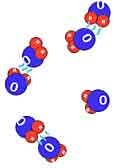More on Collisions
 What's wrong with the picture of the two colliding water molecules?
What's wrong with the picture of the two colliding water molecules?
 In one sense, nothing, because things do bump into each other in a liquid. But water molecules
don't have to physically touch each another for damping to occur.
In one sense, nothing, because things do bump into each other in a liquid. But water molecules
don't have to physically touch each another for damping to occur.
 Huh? How can there be damping if there is no contact?
Huh? How can there be damping if there is no contact?
 Remember that the hydrogen and oxygen each have a slight net charge in a water molecule. You don't
have to be touching another charge to feel a force from it. A charge will feel some
electric force even far away from another charge.
Remember that the hydrogen and oxygen each have a slight net charge in a water molecule. You don't
have to be touching another charge to feel a force from it. A charge will feel some
electric force even far away from another charge.
 How does that lead to damping?
How does that lead to damping?
 Each of the positively-charged hydrogens in a water molecule is attracted to all of the other
negatively-charged oxygens. No matter which direction you rotate the water molecule, you always have
to pull some of the hydrogens away from some of the oxygens. This damps the motion.
Each of the positively-charged hydrogens in a water molecule is attracted to all of the other
negatively-charged oxygens. No matter which direction you rotate the water molecule, you always have
to pull some of the hydrogens away from some of the oxygens. This damps the motion.
|

|
 Ok, you've convinced me that there should be attractive forces between water molecules. But they
can't be very strong, can they?
Ok, you've convinced me that there should be attractive forces between water molecules. But they
can't be very strong, can they?
 You're right. These attractive forces aren't nearly as strong as the forces that hold a water molecule
together. Yet a lot of little forces can add up to a sizable force. Remember, there are a lot of
molecules in liquid water.
You're right. These attractive forces aren't nearly as strong as the forces that hold a water molecule
together. Yet a lot of little forces can add up to a sizable force. Remember, there are a lot of
molecules in liquid water.
|

|
 This attractive force is an example of a hydrogen bond, which is important in water and certain
other compounds containing hydrogen and either nitrogen, oxygen or fluorine. In water this hydrogen
bonding is responsible for its high melting and boiling points. So next time you're boiling water and
it seems to take forever, you'll now know why.
This attractive force is an example of a hydrogen bond, which is important in water and certain
other compounds containing hydrogen and either nitrogen, oxygen or fluorine. In water this hydrogen
bonding is responsible for its high melting and boiling points. So next time you're boiling water and
it seems to take forever, you'll now know why.
 Yeah, you have to overcome all of those little attractive forces.
Yeah, you have to overcome all of those little attractive forces.





